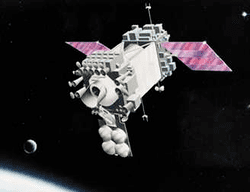Names MSX SATCAT no. 23851 Launch site Vandenberg AFB SLC-2W Launch date 24 April 1996 Launch mass 2,700 kg Rocket Delta | COSPAR ID 1996-024A Website MSX home page Period 1.7 hours Launch mass 2,700 kg | |
 | ||
Similar Wide Field Infrared Explorer, Gamma, High Energy Astronom, Hakucho, Tenma | ||
The Midcourse Space Experiment (MSX) is a Ballistic Missile Defense Organization (BMDO) satellite experiment (unmanned space mission) to map bright infrared sources in space. MSX offered the first system demonstration of technology in space to identify and track ballistic missiles during their midcourse flight phase.
Contents
History
On 24 April 1996, the BMDO launched the MSX satellite on a Delta II booster from Vandenberg AFB, California. MSX was placed in a sun-synchronous orbit at 898 km and an inclination of 99.16 degrees. MSX's mission was to gather data in three spectral bands (long wavelength infrared, visible, and ultraviolet). MSX became a contributing sensor to the Space Surveillance Network on 13 May 1998.
Operations
Operational from 1996–1997, MSX mapped the galactic plane and areas either missed or identified as particularly bright by the Infrared Astronomical Satellite (IRAS) at wavelengths of 4.29 µm, 4.35 µm, 8.28 µm, 12.13 µm, 14.65 µm, and 21.3 µm. It carried the 33-cm SPIRIT III infrared telescope with solid hydrogen-cooled five line-scanned infrared focal plane arrays.
Calibration of MSX posed a challenge for designers of the experiment, as baselines did not exist for the bands it would be observing under. Engineers solved the problem by having MSX fire projectiles of known composition in front of the detector, and calibrating the instruments to the known black-body curves of the objects. The MSX calibration serves as the basis for other satellites working in the same wavelength range, including AKARI (2006-2011) and the Spitzer Space Telescope (SST).
MSX data is currently available in the Infrared Science Archive (IRSA) provided by NASA's Infrared Processing and Analysis Center (IPAC). Collaborative efforts between the Air Force Research Laboratory and IPAC has resulted in an archive containing images for about 15 percent of the sky, including the entire Galactic Plane, the Large Magellanic Cloud, and regions of the sky missed by IRAS.
